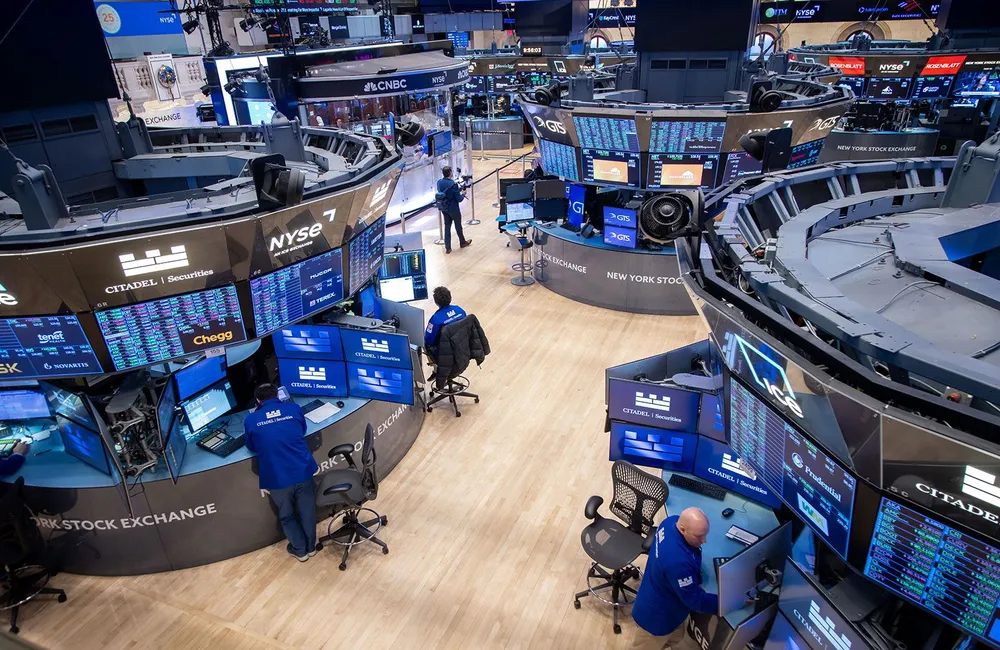ASX futures were up 8 points, or 0.1 per cent, to 7130 at 8.00 am AEST Wednesday, suggesting a small bounce at the open.
Overseas, the S&P 500 slumped 0.8%. The tech-heavy Nasdaq Composite fell 2.3 percent, with Alphabet plunging 5 percent, its worst one-day performance since October 2020. Meta Platforms, the owner of Facebook, dropped 7.6%. Gains in defensive and cyclical names lifted the Dow Jones Industrial Average to a near-the-bell rally that left it up 0.2%, after declining as much as 1.6% intradaily.
Snap’s warning about a deteriorating economy frightened technology investors looking for a bottom in a fast-accelerating rout on the share market. Shares of Snap fell 43 percent when the company said profits would be weaker than expected and hiring would slow in a deteriorating macroeconomic environment. Investors also processed data that showed sales of new US homes dropped to the lowest level since the pandemic in April, lagging economist forecasts in a sign that higher rates are biting the real economy.
“What’s different in the last few weeks is the range of concerns has widened so dramatically,” said Eric Leve, chief investment officer at the investment-management firm Bailard. “It was inflation that was in everyone’s face for so long. Now, it's far beyond that."
The S&P/ASX 200 finished down 0.3% at 7128.8 in Australia, as gains by the financial sector couldn’t make up for weakness in most other sectors.
ANZ, Westpac, Commonwealth and NAB added between 0.2% and 1.0% but the benchmark index struggled to extend positive momentum from US stocks.
Tech, industrial and retail stocks were among those that fell as our risk-off sentiment was reflected by weakness in most Asian currencies.
Every ASX 200 tech stock fell, with Block's 7.3% tumble leading the pack. Nufarm fell 15% as Sumitomo Chemical announced the sale of its stake in the agricultural chemical company.
Pushpay rose 15.6 percent to five-month high of $1.295 after the Auckland-based online donor management solution for US churches said it was considering multiple takeover offers.
Tabcorp spin-off The Lottery Corporation hit the boards on the ASX under ticker code TLC, closing at $4.70.
Tabcorp itself fell $4.285, or 83%, to $1.055, because those shares no longer represent Tabcorp’s keno or lottery businesses.
Brent crude oil gained 0.4% to US$113.90 a barrel in commodity markets. Iron ore tumbled 4% to US$130.50. Gold was flat at US$1870.50.
In local bond markets yield on Australian 2 Year government bonds fell to 2.46% whilst the 10 Year was on 3.31%. Bonds were buoyed globally as equities lagged, with yield on US Treasury 2 Year notes falling to 2.48% while 10 Year shaded down to 2.75%. Yields fell as prices rose.
The Australian dollar was buying 71.06 US cents at 7.74 am AEST, 71.08 US cents at the close previously. The Wall Street Journal Dollar index measuring the dollar versus 16 other currencies fell further to 94.50.
Asia
Chinese shares closed down despite Beijing unveiling a series of economic stimulus measures late on Monday. The market is likely to see some further fluctuations in the near term, given that a distinct path toward economic recovery has yet to materialize, analysts from Central China Securities said in a note. However, in the longer term, the brokerage expects an overall recovery as China starts to gradually unwind its pandemic restrictions. The benchmark Shanghai Composite Index lost 2.4% and ended at 3070.93, while the Shenzhen Composite Index dropped 3.6% to 1922.48. The ChiNext Price Index, which is heavy on technology stocks, was the biggest loser, dropping 3.8% to close at 2318.07. The biggest losers were construction contractors, engineering companies and iron-ore miners.
Hong Kong stocks closed lower as selling pressure signs continued to build following a rebound last week. The decline followed losses in the China market as investors were wary despite Beijing’s latest plans for economic stimulus. Hong Kong's Hang Seng Index closed down 1.7% at 20112.10. Losses were widespread across a mixed bag of sectors, with casino operator Sands China slumping 7.5% to book the worst show on the index. EV maker BYD lost 5.8% and real-estate provider Country Garden Services dropped 5.6%.
Japanese shares closed lower, weighed down by declines in tech and electronics stocks, with concerns over slower economic growth and higher operations cost also continuing to the forefront. Renesas Electronics fell 5.0% and Recruit Holdings lost 6.6%. The Nikkei Stock Average dropped 0.9% to 26748.14. Investors continued to hone in on President Biden’s trip to Tokyo, and any potential ramifications it may have for global trade.
Europe
European stocks dropped as the sentiment turned negative after poor equity and economic news. The pan-European Stoxx Europe 600, along with the French CAC 40 and German DAX, all declined by more than 1%.
“European markets have given up some of the gains of yesterday as a slug of further US economic weakness in the shape of a large downgrade to earnings from social-media company Snap and softer PMI reports, point toward rising prices crimping profits and demand,’’ CMC analyst Michael Hewson says.
London’s FTSE 100 slipped 0.39 percent Tuesday, sticking closer to its bounce from the previous day than other markets that took bigger dives.
“It’s normal service resumes for equities, as the great market selloff of 2022 begins yet again,” says Chris Beauchamp, chief market analyst at IG Group PLC.
It’s no secret now to even the most eager purchaser that markets aren’t going to rebound any time soon but while most indices have swayed, the FTSE 100 has pretty much stayed put, says Beauchamp. “It’s rarely been a better time to be an index dominated by commodity-linked stocks which once again have held the pass as virtually every other index heads sharply into the red,” Beauchamp says.
North America
U.S. stock indexes finished mostly lower and a selloff in technology stocks deepened as worries about economic growth and rising interest rates continued to pressure markets.
The S&P 500 fell 0.8%. The tech-heavy Nasdaq Composite fell 2.3 percent, weighed down especially by Alphabet, which fell 5 percent, its worst single-day performance since October 2020. Meta Platforms, which owns Facebook, dipped 7.6%. Gains in defensive and cyclical names lifted the Dow Jones Industrial Average nearly to the closing bell to end up 0.2%, having been down as much as 1.6% at one point in the session.
All three of the major indexes were deeper in the red on Tuesday morning as reports about home sales and corporate outlooks had investors in a downbeat mood. Stocks rebounded to some degree later in the day, but investors said there were good reasons to be pressing to get into the market and that the battle was uphill as even more negative signs about the economy’s health pile up.
“What’s changed in the last few weeks is that the spectrum of concerns has widened so dramatically,” says Eric Leve chief investment officer for the investment-management firm Bailard. “It was inflation that was front and center for everybody for so long. Now, it's far beyond that."
The Federal Reserve’s preparations to combat scorching inflation, along with its plans to lift interest rates, were the first of a parade of frights markets have faced over 2022. More recently, as a rough year on Wall Street continues, warring in Ukraine, high prices for food and energy and a slew of lukewarm outlooks from major companies have kept investors on edge.
“There’s normally something that’s the catalyst of the turnaround, and it’s the Fed,” said Russ Koesterich, who co-manages a global-allocation fund for BlackRock. “This time around, the Fed has obviously a harder time being able to come to the rescue given that they’ve got so much work to do still on combating inflation.”
Pressuring investors on Tuesday was a profit and revenue warning from social-media company Snap a day earlier that soured sentiment on the tech sector. And then there was a disappointing report Tuesday on US new-home sales in April that soured the mood even more.
Snap’s shares fell $9.68, or 43 percent, to close at $12.79 on Tuesday as investors absorbed its comments that the macroeconomic environment had worsened more than anticipated. Concerns about a hit to Snap’s advertising revenue reverberated to other tech stocks that have gotten hammered this year.
The home-sales data, well below economists’ top-line expectations, are also another indication that the Fed’s interest-rate rises are already being felt in the real economy, said Steven Ricchiuto, the chief economist for Mizuho Securities USA.
“It’s a relatively weak number,” he said, noting that the trend signals that more home buyers are being squeezed out of the market as interest rates on mortgages rise.
Fears of slowing growth in the face of rising inflation have contributed to the S&P 500’s 18% drop through Tuesday from a peak in January. Investors have been worried that the S&P 500 might tip into bear-market territory, defined as a fall of at least 20 percent from a recent high. The benchmark index was on the verge of ending in a bear market on Friday, before being lifted by a late-session rally.
On Tuesday, while big tech companies got a beating, stocks that had a greater footing on the physical economy absorbed more muted damage or were higher. Consumer staples, energy and real estate, some of the S&P 500 sectors that finished in the black.
Tim Courtney, chief investment officer of Exencial Wealth Advisors, interpreted that as evidence that inflation and the Fed’s response was still a bigger concern for many investors than the economy’s underlying health.
Wealth-management clients had previously been weathering the stock market’s downturn this year with equanimity, but now that the S&P 500 has come within the bear-market range, their fear has intensified, Mr. Courtney said.
“I think concerns started to build in the past week as we approached that magical bear-market barrier.”
The selloff in technology stocks Tuesday drove investors into government bonds, with the yield on the benchmark 10-year US Treasury note plunging to 2.758%, from 2.857% Monday. A bond’s yield drops when its price goes up.
Turbulent trading across both stock and bond markets this year has caused Mr. Koesterich at BlackRock to keep more cash in the fund’s portfolio, he said.
“A lot of the volatility in the stock markets has come from the volatility in rates markets,” he added. “In that environment, cash is one of the best risk mitigants.”
Pervasive disappointing earnings and warnings from the corporate forefront have only added to the fears. Abercrombie & Fitch became the latest retailer on Tuesday to sap investor optimism after swinging to a first-quarter loss on higher costs. The company’s shares fell $7.64, or 29 percent, to $19.09.
As analysts increasingly reckon with the Fed’s unyielding determination to wrestle down inflation, expectations for corporate earnings on Wall Street may fall further, dragging stock prices lower, warned Mr. Ricchiuto of Mizuho.
Even with the broad technology selloff on Tuesday, there were some bright spots in the market. Zoom Video Communications rose $5.01, or 5.6 percent, to $94.34 after the videoconferencing-services firm raised its profit outlook.





















